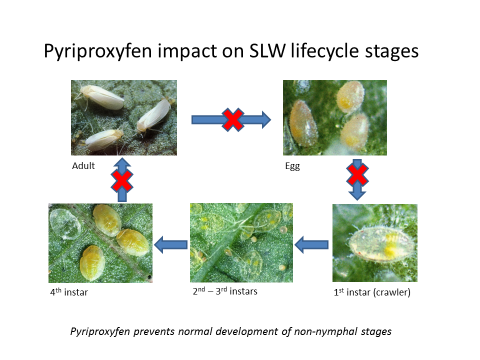With the current season shaping up to be one of high insect pressure, we may see silverleaf whitefly (SLW), Bemisia tabaci reach problematic levels in regions outside of their traditional range. For growers and agronomists not familiar with their control it is worth investing some time to understand how one of the main registered insecticides, pyriproxyfen, works.
What is pyriproxyfen?
Pyriproxyfen (originally marketed as Admiral®, although several other products with this active are now available) is an insect growth regulator (IGR) that mimics juvenile hormone, a natural occurring hormone in the adult and early nymphal stages of whitefly. Juvenile hormone is a necessary chemical produced during an insect’s development, but becomes toxic when present during metamorphosis. Pyriproxyfen has three main effects on SLW:
- Inhibits egg hatch
- Inhibits metamorphosis of late instar nymphs to adults
- Reduces the fecundity of adult females (eggs laid are sterile)
Pyriproxyfen is not directly toxic to adults, so population changes are not immediately obvious post-application. At 25°C, juvenile development (egg to adult) and the average lifespan of an adult female are both 24 days. It can therefore take as long as 3 weeks after spraying to see the full effect of a pyriproxyfen application, although in most situations a result should become evident after 14-16 days.
Translaminar activity
Pyriproxyfen has translaminar activity (i.e. the insecticide is able to pass through the leaf from the upper to the lower surfaces). This means it is able to achieve good contact with SLW, which spends most of its time on the lower leaf surface. SLW move regularly throughout the canopy so even on a crop that has growth dilution the adults should still be exposed to pyriproxyfen as they move about the canopy. International research suggests that feeding on treated foliage every 48 hours should be sufficient to induce female sterility.
IPM fit and bioresidual impact
One of the positive aspects of pyriproxyfen is its relatively low toxicity on natural enemies, including the parasitoid Eretmocerus hayati. This means that pyriproxyfen will have minimal disruption of beneficials and their activity post application can help to suppress SLW population growth. A significant key to the efficacy of pyriproxyfen is that natural enemies remain in place and are often able to continue supressing SLW populations long after the residues of pyriproxyfen have worn off. This effect is commonly termed “bioresidual” and is responsible for pyriproxyfen leading to suppressed levels of SLW for many weeks. If natural enemies have been disrupted by the use of other pesticides prior to the application of pyriproxyfen, the control provided by this product will be much shorter lived and it is likely that retreatment with another compound could be required 3-4 weeks after application.
Conserving natural enemies is the key to maximising the bioresidual benefits of pyriproxyfen.
When to use pyriproxyfen
The cotton Insecticide Resistance Management Strategy (IPMS) restricts pyriproxyfen to a single application per field per season, so the timing of application can be one of the more challenging decisions agronomists and growers need to make in regards to SLW management. To assist, a threshold matrix has been developed (see the Cotton Pest Management Guide for more information). By tracking population growth over time, it’s possible to predict the likely trajectory of the population and make a decision on whether to treat now, or delay, or not treat at all.
SLW feeding has negligible impact on yield. Managing SLW is about avoiding honeydew contamination of open cotton. Therefore, given pyriproxyfen is slow acting, critical things to consider before application are:
- time left before there is open cotton present
- time left to defoliation
- presence of honeydew.
Examples of appropriate use
DO NOT USE: Prior to 1450 DD (day degrees) it is better to hold off using pyriproxyfen even if high populations of SLW are present. If other pests are present in the field and require control, consider using a product that gives control or suppression of SLW e.g. diafenthiuron (mites & aphids) spirotetramat (aphids), cyantraniliprole (helicoverpa).
USE: Beyond 1450 DD, if around 30% to 40% leaves are infested, the SLW population is increasing, and open cotton is still a couple of weeks away then the use of pyriproxyfen would be a good choice.
DO NOT USE: If honeydew is already present on lower leaves and open cotton is imminent the opportunity to use pyriproxyfen has passed.
Risk of resistance
The risk of SLW developing resistance to pyriproxyfen is high and testing by the Queensland Department of Agriculture and Fisheries as part of a CRDC funded research project, has recently found a single case of resistance in cotton from Northern NSW. Other registered products tested have not displayed evidence of resistance. At this stage it would be expected that pyriproxyfen should still deliver good field efficacy. If you are concerned about a field application failure please contact the authors.
Further information
For further information on SLW including sampling, the threshold matrix and control options please consult the 2016-17 Cotton Pest Management Guide.

